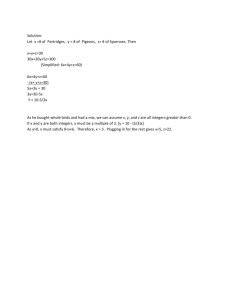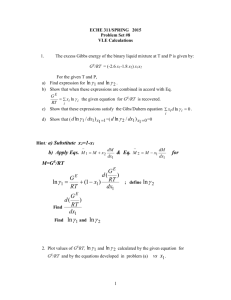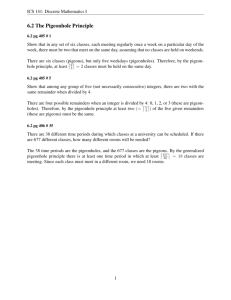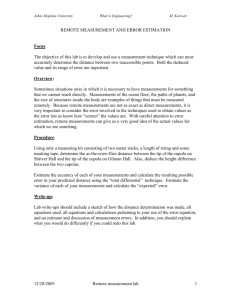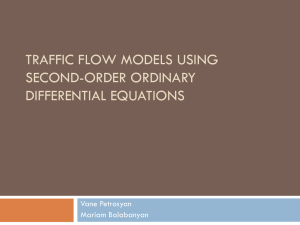Document
advertisement
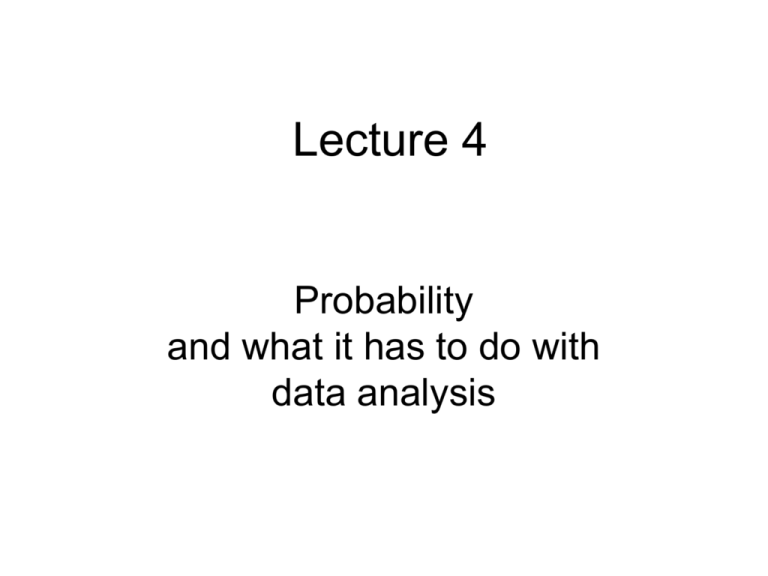
Lecture 4
Probability
and what it has to do with
data analysis
Please Read
Doug Martinson’s
Chapter 2: ‘Probability Theory’
Available on Courseworks
Abstraction
Random variable, x
it has no set value, until you ‘realize’ it
its properties are described by a
distribution, p(x)
Probability density distribution
When you realize x
the probability that the value you get is
between x and x+dx
is p(x) dx
the probability, P, that the value you get is
is between x1 and x2
x
is P = x p(x) dx
2
1
Note that it is written with a capital P
And represented by a fraction between
0 = never
And
1 = always
p(x)
Probability P that x is
between x1 and x2 is
proportional to this area
x
x1
x2
p(x)
Probability that x is between - and +
is unity, so total area = 1
x
the probability that the value you get is
is something is unity
+
- p(x) dx = 1
Or whatever the allowable range of x is …
Why all this is relevant …
Any measurement is that contains noise is treated
as a random variable, x
The distribution p(x) embodies both the ‘true value’
of the quantity being measured and the
measurement noise
All quantities derived from a random variable are
themselves random variables, so …
The algebra of random variables allows you to
understand how measurement noise affects
inferences made from the data
Basic Description of Distributions
Mode
x at which distribution has peak
most-likely value of x
p(x)
peak
xmode
x
But modes can be deceptive …
100 realizations of x
Sure, the 1-2 range has the most
counts, but most of the
measurements are bigger than 2!
N
3
18
11
8
11
14
8
7
11
9
p(x)
peak
x
0-1
1-2
2-3
3-4
4-5
5-6
6-7
7-8
8-9
9-10
0
xmode
x
10
Median
50% chance x is smaller than xmedian
50% chance x is bigger than xmedian
p(x)
No special
reason the
median
needs to
coincide with
the peak
50%
50%
xmedian
x
Expected value or ‘mean’
p(x)
x you would get if you took the mean
of lots of realizations of x
Let’s examine a discrete
distribution, for simplicity ...
4
3
2
1
0
1
2
3
x
Hypothetical table of 140 realizations of x
x
1
2
3
Total
mean =
=
N
20
80
40
140
[ 20 1 + 80 2 + 40 3 ] / 140
(20/140) 1 + (80/140) 2 + (40/140) 3
=
p(1) 1 + p(2) 2 + p(3) 3
=
Σi
p(xi) xi
by analogy
for a smooth distribution
Expected value of x
E(x) = -
+
x p(x) dx
by the way …
You can compute the expected (“mean”)
value of any function of x this way …
E(x) = -
E(x2)
= -
E(x) =
etc.
+
x p(x) dx
+
+
-
x2 p(x) dx
x p(x) dx
Beware
E(x2) E(x)2
E(x) E(x)2
and so forth …
Width of a distribution
p(x)
Here’s a perfectly sensible way to
define the width of a distribution…
50%
25%
W50
25%
x
… it’s not used much, though
Width of a distribution
Here’s another way…
p(x)
Parabola [x-E(x)]2
E(x)
x
… multiply and integrate
p(x)
Idea is that if distribution is narrow, then
most of the probability lines up with the
low spot of the parabola
[x-E(x)]2 p(x)
E(x)
But if it is wide, then some of the
probability lines up with the high
parts of the parabola
Compute
this total
area …
E(x)
Variance =
x
s2
= -
+
[x-E(x)]2 p(x) dx
x
variance = s
p(x)
A measure of width …
s
E(x)
x
we don’t immediately know its
relationship to area, though …
the Gaussian or normal
distribution
variance
expected value
p(x) =
1
(2p)s
exp{ -
2
(x-x)
/
Memorize me !
2
2s
)
p(x)
x=1
s=1
Examples of
x
Normal
p(x)
Distributions
x=3
s = 0.5
x
Properties of the normal distribution
Expectation =
Median =
p(x)
Mode = x
95%
x
x-2s x
x+2s
95% of
probability
within 2s of
the expected
value
Functions of a random variable
any function of a random variable is itself a random variable
If x has distribution p(x)
the y(x) has distribution
p(y) = p[x(y)] dx/dy
This follows from the rule for
transforming integrals …
1 = x1 p(x) dx = y1 p[x(y)] dx/dy dy
x2
y2
Limits so that y1=y(x1), etc.
example
Let x have a uniform (white) distribution of [0,1]
p(x)
1
0
x
1
Uniform probability that x is anywhere between 0 and 1
Let y = x2
then x=y½
y(x=0)=0
y(x=1)=1
dx/dy=½y-½
p[x(y)]=1
So p(y)=½y-½ on the interval [0,1]
1
Numerical test
histogram of 1000 random numbers
Histogram of x,
generated with
Excel’s rand()
function which
claims to be based
upon a uniform
distribution
Histogram of x2,
generated by
squaring x’s from
above
Plausible
that it’s
uniform
Plausible
that it’s
proportional
to 1/y
multivariate distributions
example
Liberty island is inhabited by both pigeons
and seagulls
40% of the birds are pigeons
and 60% of the birds are gulls
50% of pigeons are white and 50% are grey
100% of gulls are white
Two variables
species s takes two values
pigeon p
Of 100 birds,
and gull g
20 are white pigeons
color c takes two values
white w
and tan t
20 are tan pigeons
60 are white gulls
0 are tan gulls
What is the probability that a bird
has species s and color c ?
a random
bird, that is
p
20%
20%
g
60%
0%
s
w
t
c
Note: sum
of all boxes
is 100%
This is called the
Joint Probability
and is written
P(s,c)
Two continuous variables
say x1 and x2
have a joint probability
distribution
and written
p(x1, x2)
with
p(x1, x2) dx1 dx2 = 1
The probability that
x1 is between x1 and x1+dx1
and
x2 is between x2 and x2+dx2
is
p(x1, x2) dx1 dx2
so
p(x1, x2) dx1 dx2 = 1
You would contour a joint
probability distribution
and it would look something like
x2
x1
What is the probability that a bird
has color c ?
Of 100
birds,
start with P(s,c)
p
20%
20%
s
g
and sum columns
60%
0%
w
t
c
To get P(c)
80%
20%
20 are
white
pigeons
20 are tan
pigeons
60 are
white
gulls
0 are tan
gulls
What is the probability that a bird
has species s ?
start with P(s,c)
p
20%
20%
s
Of 100 birds,
20 are white
pigeons
20 are tan
pigeons
60 are white
gulls
0 are tan
gulls
g
60%
0%
w
t
c
40%
and
sum
rows
60%
To get P(s)
x2
These operations make sense with
distributions, too
x2
x2
x1
p(x1)
x1
x1
p(x1) = p(x1,x2) dx2
distribution of x1
(irrespective of x2)
p(x2) = p(x1,x2) dx1
distribution of x2
(irrespective of x1)
p(x2)
Given that a bird is species s
what is the probability that it has color c ?
Of 100 birds,
20 are white pigeons
p
50%
50%
g
100%
0%
s
20 are tan pigeons
60 are white gulls
0 are tan gulls
w
t
c
Note, all
rows sum
to 100
This is called the
Conditional Probability of c given s
and is written
P(c|s)
similarly …
Given that a bird is color c
what is the probability that it has species s ?
Of 100 birds,
20 are white pigeons p
20 are tan pigeons
25%
100%
75%
0%
s
60 are white gulls
0 are tan gulls
So 25% of white
birds are pigeons
g
w
t
c
Note, all
columns
sum to 100
This is called the
Conditional Probability of s given c
and is written
P(s|c)
Beware!
P(c|s)
p
50%
p
50%
s
P(s|c)
25%
100%
75%
0%
s
g
100%
0%
w
t
c
g
w
t
c
note
P(s,c) = P(s|c) P(c)
p
20
p
20
25
100
=s
s
g
60
w
0
c
t
25% of 80 is 20
g
75
80
20
0
w
w
c
t
t
c
and
P(s,c) = P(c|s) P(s)
50% of 40 is 20
p
20
p
20
50
50
=s
s
g
60
w
0
c
t
p
g
100
40
s
0
g
w
c
t
60
and if
P(s,c) = P(s|c) P(c) = P(c|s) P(s)
then
P(s|c) = P(c|s) P(s) / P(c)
and
P(c|s) = P(s|c) P(c) / P(s)
… which is called Bayes Theorem
Why Bayes Theorem is important
Consider the problem of fitting a straight line to data, d,
where the intercept and slope are given by the vector
m.
If we guess m and use it to predict d we are doing
something like P(d|m)
But if we observe d and use it to estimate m then we are
doing something like P(m|d)
Bayes Theorem provides a framework for relating what
we do to get P(d|m) to what we do to get P(m|d)
Expectation
Variance
And
Covariance
Of a multivariate distribution
The expected value of x1 and x2 are calculated in a
fashion analogous to the one-variable case:
E(x1)= x1 p(x1,x2) dx1dx2 E(x2)= x2 p(x1,x2) dx1dx2
Note
E(x1) = x1 p(x1,x2) dx1dx2
x2
= x1 [ p(x1,x2)dx2 ] dx1
x1
= x1 p(x1) dx1
So the formula really is just
the expectation of a onevariable distribution
The variance of x1 and x2 are calculated in a fashion
analogous to the one-variable case, too:
sx12= (x1-x1)2p(x1,x2) dx1dx2 with x1=E(x1)
and similarly for sx22
Note, once again
sx12= (x1-x1)2p(x1,x2) dx1dx2
x2
= (x1-x1)2 [p(x1,x2) dx2] dx2
= (x1-x1)2p(x1) dx1
x1
So the formula really is just the
variance of a one-variable
distribution
Note that in this distribution
if x1 is bigger than x1, then x2 is bigger than x2 and
if x1 is smaller than x1, then x2 is smaller than x2
x2
This is a
positive correlation
x2
x1
x1
Expected value
Conversely, in this distribution
if x1 is bigger than x1, then x2 is smaller than x2 and
if x1 is smaller than x1, then x2 is smaller than x2
x2
This is a
negative correlation
x2
x1
x1
Expected value
This correlation can be quantified by multiplying the
distribution by a four-quadrant function
x2
x2
x1
-
+
+
-
x1
And then integrating. The function (x1-x1)(x2-x2) works
fine
cov(x1,x2) = (x1-x1) (x2-x2) p(x1,x2) dx1dx2
Called the “covariance”
Note that the vector x with elements
xi = E(xi)= xi p(x1,x2) dx1dx2
is the expectation of x
and the matrix Cx with elements
Cij = (xi-xi) (xj-xj) p(x1,x2) dx1dx2
has diagonal elements equal to the variance of xi
Cxii = sxi2
and
off-diagonal elements equal to the covariance of xi and xj
Cxij = cov(xi,xj)
“Center” of multivatiate distribution
x
“Width” and “Correlatedness” of multivariate
distribution
summarized a lot – but not everything –
about a multivariate distribution
Functions of a set of random
variables, x
A vector of of N
random variables
in a vector, x
given y(x)
Do you remember how to
transform the integral
… p(x)
N
d x
=
… ? dNy =
given y(x)
then
… p(x)
N
d x
=
… p[x(y)] |dx/dy| dNy =
Jacobian determinant, that is,
the determinant of matrix Jij
whose elements are dxi/dyj
But here’s something that’s EASIER …
Suppose y(x) is a linear function y=Mx
Then we can easily calculate the
expectation of y
yi = E(yi) = … yi p(x1 … xN) dx1…dxN
= … SMijxj p(x1 … xN) dx1… dxN
= S Mij … xj p(x1 … xN) dx1 … dxN
= S Mij E(xi) = S Mij xi
So y=Mx
And we can easily calculate the covariance
Cyij = … (yi – yi) (yj – yj) p(x1,x2) dx1dx2
= … ΣpMip(xp – xp) ΣqMjq (xq – xq) p(x1…xN) dx1…dxN
= ΣpMip ΣqMjq … (xp – xp) (xq – xq) p(x1…xN) dx1 …dxN
= ΣpMip ΣqMjq Cxpq
So Cy = M Cx MT
Memorize!
Note that these rules work
regardless of the distribution of x
if y is linearly related to x, y=Mx
then
y=Mx
(rule for means)
Cy = M Cx MT
(rule for propagating error)
